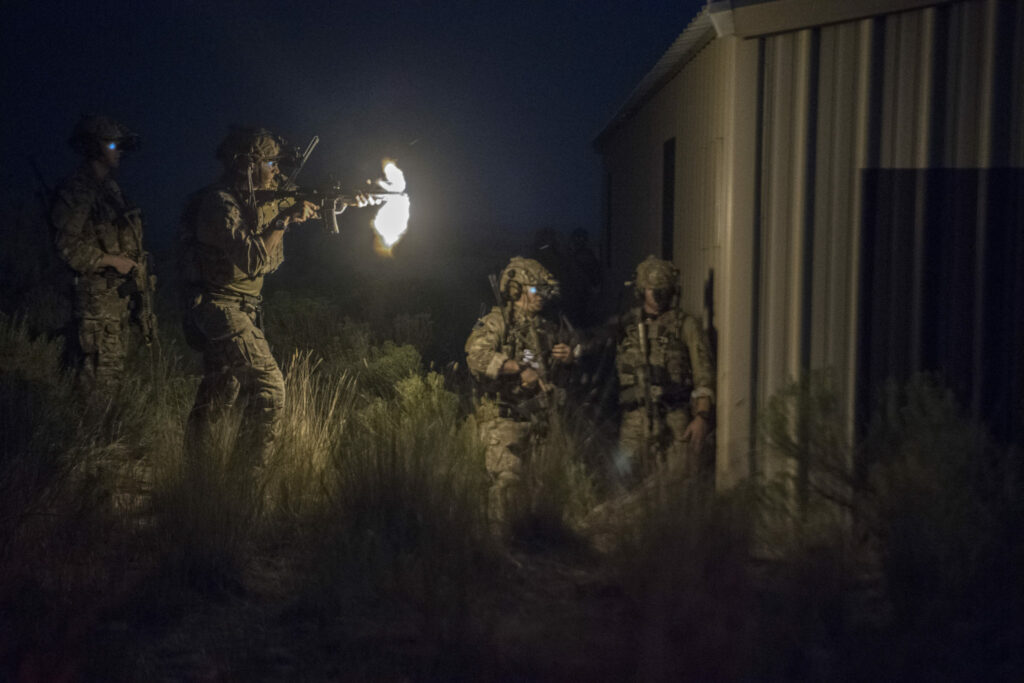Joe McGiffin has served in the United States Army for seven years. He is currently pursuing a M.A. in International Relations prior to teaching Defense and Strategic Studies at the United States Military Academy at West Point. He can be found on Twitter @JoeMcGiffin. Divergent Options’ content does not contain information of an official nature nor does the content represent the official position of any government, any organization, or any group.
Title: Assessing Shortcomings of the U.S. Approach for Addressing Conflict Below the Threshold of War.
Date Originally Written: August 13, 2021.
Date Originally Published: September 6, 2021.
Author and / or Article Point of View: The author is an active-duty service member. This article is written from the point of view of the U.S. toward the anticipated operating environment of the next thirty years.
Summary: The current U.S. national security approach is not suitable for addressing threats below the threshold of war. This approach focuses on achieving security through military superiority. A more effective approach would achieve national security objectives derived from an analysis of geopolitical trends. This new approach will allow for more unified, synergistic use of national resources in the defense of U.S. interests.
Text: By its own estimate, the United States is losing global influence as a result of strategic atrophy, permitting other actors the freedom to reshape the weakening world order through “all-of-nation long-term strategy[1].” However, myopia, not atrophy, has eroded U.S. advantages. A new approach, one that can frame its national security problems within the changing geopolitical context, will result in a more resilient and agile security strategy.
The current U.S. approach is a dangerous misinterpretation of the Revolution in Military Affairs (RMA) theory that originated from Soviet observations of the United States’ Second Offset Strategy which ended the Cold War[2]. Nuclear weapons created a conflict threshold, which neither power would cross, and spurred a race to tactical dominance in conflict below that level. Between their own success and the proliferation of assets which promised dominant battlefield knowledge, maneuver, and precision[3], the United States concluded that military supremacy was synonymous with national security. Though the defense community rebrands it as a new concept every decade (i.e., Transformation and Defense Innovative Initiative), the intellectual underpinnings do not change[4].
While RMA theory is appealing, history proves two points: that superior weaponry rarely equates directly to a strategic advantage; and that overemphasis on such advances disregards other critical factors of national security[5]. While military advancements have had profound impacts on the rise and fall of global powers in the past, those innovations were seldom developed in isolation from revolutionary change in society or culture[6]. For example, it was the socioeconomic isolation of the East and West that created the conditions for an arms race to determine the victor of the Cold War, not the weapons themselves. Near-exclusive focus on the military aspect of national security has left the United States committed to the pursuit of tactical superiority at the expense of strategic flexibility.
The Third Offset Strategy (3OS) and F-35 Joint Strike Fighter Program both illustrate this issue. The 3OS hinges entirely on having a technological advantage to negate adversary Anti-Access/Area Denial Operations: industrial espionage or an adversary’s own disruptive innovations could plausibly neutralize the 3OS rapidly enough to significantly disrupt U.S. foreign policy[7]. The F-35, for its part, demonstrates another issue. While the apex of air power for now, it came at exorbitant cost and will continue to be a resource strain on the U.S. defense budget[8]. Furthermore, whether or not the F-35 was worth the price is an important question with implications for future strategy. While military supremacy has continued to fill a pivotal role in deterring war between major actors, it is not a fungible advantage; that is, military innovations can be used only in military conflicts or to deter them. While the F-35 may be the best fighter available, it is important to consider what measurable security advantages it has or has not achieved for the United States and its other investors.
Today’s environment requires the United States to adopt a more inclusive framework for achieving security goals. Instead of focusing resources into a single element of power (i.e., the military), it could use a more comprehensive approach grounded in geopolitical analysis. Instead of preparing for future war, it could focus on the threats posed by the present: subversive tactics and strategic maneuvers by aggressors deliberately avoiding the overt use of military force. The new paradigm would strive for synergy across as many public and private stakeholders as possible in order to achieve a unified effort to secure national interests.
As an example, use of space assets, because of their extreme expense, has only been possible through close cooperation of the private and public sector. Co-usage of platforms between the military, government, and private sector continues to be a hallmark of this domain[9]. That synergistic use of resources to achieve specific goals, if applied to national security means across the other domains, will offer far more flexibility and resiliency than strict reliance on what military power can achieve.
While conventional war is the purview of the military, conflict below that threshold is far more calculated and nuanced. In order to retain its position of power and influence in the future, the United States will be required to synchronize its national resources in pursuit of security goals within the greater geopolitical context. The RMA-inspired Cold War paradigm will be supplanted by one with renewed emphasis on operating environment variables instead of arbitrary strategic means.
Endnotes:
[1] United States Department of Defense (2018). Summary of the 2018 National Defense Strategy of the United States of America (NDS 2018). https://dod.defense.gov/Portals/1/Documents/pubs/2018-National-Defense-Strategy-Summary.pdf United States Department of Defense. See also; Biden, J. (2021). Interim National Security Strategic Guidance. The White House. https://www.whitehouse.gov/wp-content/uploads/2021/03/NSC-1v2.pdf.
[2] Beier, J.M. (2006). Outsmarting Technologies: Rhetoric, Revolutions in Military Affairs, and the Social Depth of Warfare. International Politics, 43(2), 266-280. DOI:10.1057/palgrave.ip.8800144. See also; Louth, J. & Taylor T. (2016) The US Third Offset Strategy. The RUSI Journal, 161(3), 66-71. DOI: 10.1080/03071847.2016.1193360
[3] Mowthorpe, M. (2005). The Revolution in Military Affairs (RMA): The United States, Russian and Chinese Views. The Journal of Social, Political, and Economic Studies, 30(2), 137-153.
[4] Jensen, B.M. (2018). The Role of Ideas in Defense Planning: Revisiting the Revolution in Military Affairs, Defence Studies, 18(3), 302-317. DOI: 10.1080/14702436.2018.1497928
[5 Gray, C.S. (2003). Strategy for Chaos: Revolutions in Military Affairs and the Evidence of History. Routledge.
[6] Murray, W. (1997). Thinking About Revolutions in Military Affairs. Joint Forces Quarterly, unk. https://apps.dtic.mil/sti/pdfs/ADA354177.pdf
[7] Wellman, A. (2019). Parity Avoidance: A Proactive Analysis of the Obsolescence of the Third Offset Strategy. Homeland Security Affairs. https://www.hsaj.org/articles/15337
[8] United States Government Accountability Office (2021). F-35 Sustainment: DOD Needs to Cut Billions in Estimated Costs to Achieve Affordability. Report to the Committee on Armed Services, House of Representatives. https://www.gao.gov/products/gao-21-505t
[9] Madry, S. (2020). Disruptive Space Technologies and Innovations: The Next Chapter. Springer Nature.
Read more from Sandboxx News:
- Chinese espionage: How Beijing is stealing away US global supremacy
- Cyberwarfare: Combatting Russian hackers and Chinese influence
- America needs new covert options for great power competition
- Move over stealth. America needs faster jets to beat China
- US and Scandinavian Special Operations: A bulwark against Russian influence
Feature image: U.S. Air Force photo by Tech. Sgt. Sandra Welch




